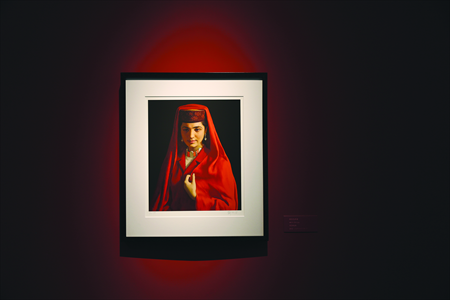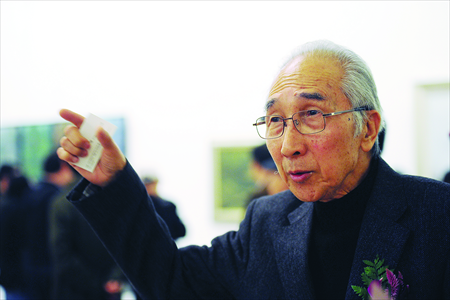Printing perfection

If a painting you like is not on exhibition and too expensive to purchase, getting a high quality print of that painting could be a way to satisfy your thirst. But nowadays, it's rare to find a print that is created under the supervision of the artist himself.
This week, the exhibition Print of Jin Shangyi's Classics at the China Academy of Fine Arts (CAFA) Art Museum presents 35 prints of both Jin's oil paintings and sketches.
Su Xinping, one of the curators of the exhibition and dean of the print department at CAFA, said that he was surprised when he first saw the prints.
"The originals were classics but as print art, these works also 'stand,'" said Su.
Jin Jun, the other curator of the exhibition as well as son of Jin Shangyi, told the Global Times that the total number of the senior Jin's paintings is very limited and are now mostly collected by different art museums in China. By producing these prints, the public can have more opportunities to see and learn about Jin's work.
Interest in portraits
Jin Shangyi, 79, is the former president of CAFA. He is seen as one of the most influential figures in the development of Chinese oil painting, especially the style of neoclassicism, addressing a combination of classicism with contemporary Chinese topics.
Jin was trained at the Russian painter K.M. Maksimov's classes at CAFA in the 1950s. There he developed his initial interest in portraits and classicism. As his understanding of art history grew, his interest in portraits became even stronger.
"Classicism has a focus on people. After the Renaissance, the heart of artists' creations was also on people. Religion related themes are about human portraits. The 17th century was also about portraits. The industrialized society studied people and their social lives," Jin Shangyi told the Global Times.
Another reason that Jin Shangyi was not only interested in portraits but also quickly became skillful is that when the People's Republic of China was founded in 1949, many artists were asked to paint Chinese leaders' portraits. As a student, Jin painted Premier Zhou Enlai as his first oil painting for a class exercise. For decades, he painted former Chinese leaders.
"The economy was not good at the time and the society had no need for art. What needed art was the country and the government," said Jin.

Neo-classical style
In the 1980s, when artists had more freedom to do whatever they wanted, Jin switched his focus to common people and their daily lives.
"Jin's contribution was that he changed the art phenomenon that China had before the 1980s," said Su. It used to be all about "historical storylines" but Jin painted people of various ages and regions depicting everyday life while maintaining a solid inheritance of classic style.
"He cares about individuals and the society," said Su.
Recently, one of Jin's paintings from 1984 has gotten a great deal of attention. The model of the oil painting - A Young Singer - is now the first lady of China, Peng Liyuan. At that time, Peng was a student at the Central Conservatory of Music and was asked by her teacher to be one of three models for Jin. That series compare Asian facial structure to that of Western classicism.
Jin's continued exploration in the possibilities of Chinese oil paintings is also reflected in his portraits of historical figures. He painted traditional Chinese painters like Kun Can (1612-92). "I wanted to explore the possible combination of ink paintings and oil paintings - how oil paintings could have the Chinese spirit," said Jin.

Promoting print art
On the market side, Jin's works are very popular. In 2009, one of his portraits of Mao Zedong sold for over 20 million yuan.
Earlier this year, several of his paintings were included in the Poly spring auctions with plans to sell this June. One estimate shows that the total transactions of Jin's works have reached 200 million yuan ($32.6 million) over the past years.
However, Jin finds that donating works to art museums is the best ending for his paintings. In 2010, Jin donated almost 40 paintings to the National Museum of China. Now, most of his works belong to art museums.
Last year, Jin also founded an art foundation to help and encourage young artists. His concern for art extended to the public, and that caring heart is also reflected in the preparation for the ongoing exhibition.
The discussion between prints' academic and business value has never stopped. Su sees the future of prints as being in the hands of the public rather than with museums or art schools. But the general understanding in China is still that only an original is worth collecting.
Thus, Jin's participation as a "celebrity artist" taking part in the process means a lot in the development of prints as a branch of the art industry in China.
"Jin is a role model and role models are influential. People see him in a print exhibition and will ask him [to explain] printing," said Su.
Not only is Jin's involvement significant, but the way he contributed also sets an example.
Jin Jun has spent two years on these prints. He visited and consulted the leading print studios in Europe and Japan. When the print satisfied his standards, senior Jin stepped in to ensure that every detail reached his standard. The process went back and forth until the prints in the exhibition had passed hundreds of editions to achieve today's quality.
"Not many artists do this for their copied works," said Su.
Tan Ping, vice-president of CAFA wrote in the preface for the exhibition that such prints are creative, not simply copies anymore. "The process, which includes multiple techniques and people from different areas of art, creates a new way [of producing art]."